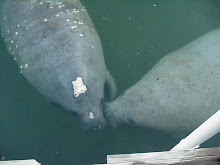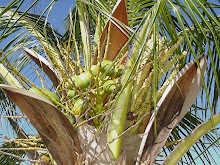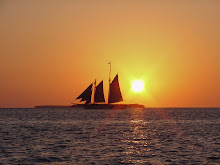We all boarded a pontoon boat. A park ranger gave us a brief history of the fort as he piloted the boat across the Matanzas River. It was a clear, sunny morning and seeing the fort across the water was quite a sight to see.
Fort Matanzas was constructed in 1740-42 as Spain's last effort to ward off British attacks and encroachments on St. Augustine.
The town had one weakness: Matanzas Inlet, 14 miles south, allowed access to the Matanzas River, by which enemy vessels could attack St. Augustine from the rear.
The trip across the river was short and soon the ranger (along with the help of ranger #2) docked the boat near the fort.

The Colonel and I were the first ones out of the boat and onto dry land (being younger and more nimble than the other tourist couple).
We tourists were given free range of the fort. The Colonel and I climbed over every inch of the fort. We climbed stairs into the fort and first saw the cannons on its gun deck.
 Then into the Soldiers' Quarters on the same level as the gun deck.
Then into the Soldiers' Quarters on the same level as the gun deck.

Soldiers were rotated from St. Augustine for one-month duty tours at Matanzas, usually an officer-in-charge, four infantrymen, and two gunners. More could be assigned to this remote outpost when there was an enemy threat, up to 50 more during a crisis.
We climbed more stairs up to the Officer's Quarters, a vaulted room directly above the Soldiers' Quarters.


 Climbing up the ladder, there was not much room to spare (remember the Spanish were a lot smaller than we are today), but The Colonel and I made it to the Observation Deck. The older couple did not attempt the climb, so The Colonel and I had the deck to ourselves.
Climbing up the ladder, there was not much room to spare (remember the Spanish were a lot smaller than we are today), but The Colonel and I made it to the Observation Deck. The older couple did not attempt the climb, so The Colonel and I had the deck to ourselves.

 We toured the fort for about half an hour.
We toured the fort for about half an hour. The boat ride back across the river was as pleasant as the one to the fort. When the boat docked we saw a large crowd of adults and children waiting for the next tour. The Colonel and I both were glad we took the early tour. I am sure the older couple were thinking the same thing.
The boat ride back across the river was as pleasant as the one to the fort. When the boat docked we saw a large crowd of adults and children waiting for the next tour. The Colonel and I both were glad we took the early tour. I am sure the older couple were thinking the same thing.Our next stop was to Fort Mose (pronounced moe-say) Historic State Park.
 This is an artist's drawing of what Fort Mose number two would have looked like.
This is an artist's drawing of what Fort Mose number two would have looked like. By the late 1600s, black slaves had learned that they could escape their British masters in the Carolina Colony and seek freedom and asylum in Spanish Florida if they embraced Catholicism and pledged to serve the Spanish Crown. In 1738 the Florida Governor granted these blacks a plot of land about two miles north of St. Augustine where they could build their own community and fort. The community housed 38 men and their families. It was estimated that about 100 people lived there. They adopted Spanish names and Spanish culture with an African flavor.
By the late 1600s, black slaves had learned that they could escape their British masters in the Carolina Colony and seek freedom and asylum in Spanish Florida if they embraced Catholicism and pledged to serve the Spanish Crown. In 1738 the Florida Governor granted these blacks a plot of land about two miles north of St. Augustine where they could build their own community and fort. The community housed 38 men and their families. It was estimated that about 100 people lived there. They adopted Spanish names and Spanish culture with an African flavor.This was the beginning of Fort Mose, North America's first free legally sanctioned Black community.
In 1740 British soldiers from the newly colonized Georgia marched toward Fort Mose, its inhabitants were safely evacuating to St. Augustine. The British troops set up camp at the abandoned Fort Mose. The next month 300 Spanish soldiers, including the black militia, staged a surprise attack on the British. They recaptured the fort, leaving 68 British dead and taking 34 prisoners. The remaining British soldiers retreated to Georgia.
With the original fort demolished, African settlers lived in St. Augustine until 1752 when a new fort and town were rebuilt.
In 1763, Florida was ceded to Britain and those living at Fort Mose evacuated along with other Spanish citizens to the northwest coast of Cuba.
The last fort we visited was the Castillo de San Marcos, St. Augustine's main fort. We did not take an inside tour (we did that in 2003), I only wanted to walk around the fort and take pictures.
 The building of the Castillo began in 1672 and it took 23 years to complete. Originally the fort was covered with white plaster and the towers in the four corners were plastered in red.
The building of the Castillo began in 1672 and it took 23 years to complete. Originally the fort was covered with white plaster and the towers in the four corners were plastered in red.The British attacked the fort in 1702 and 1740, but both times the Spanish were able to defend themselves from within the fort. It is an impressive fortress. I will let the pictures speak for themselves.





 In addition to visiting the forts on day two, The Colonel and I took a tour of the local winery, lunched at Columbia Restaurant, walked other cemeteries (more buried Blanchard family members), drove through Lincolnville (a historic black community of St. Augustine where Dr. Martin Luther King stayed while there, we drove by the houses) and we also saw an exact replica of the statue of David on the grounds of the Ripley's Believe It or Not Museum.
In addition to visiting the forts on day two, The Colonel and I took a tour of the local winery, lunched at Columbia Restaurant, walked other cemeteries (more buried Blanchard family members), drove through Lincolnville (a historic black community of St. Augustine where Dr. Martin Luther King stayed while there, we drove by the houses) and we also saw an exact replica of the statue of David on the grounds of the Ripley's Believe It or Not Museum.






































No comments:
Post a Comment